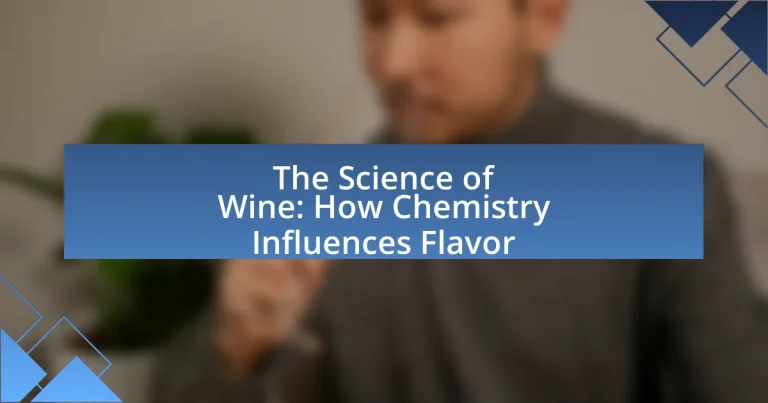The main entity of the article is the science of wine, specifically how chemistry influences flavor. The article explores the chemical processes involved in wine production, including fermentation and aging, and highlights the role of various compounds such as acids, sugars, and phenolics in shaping the wine’s taste and aroma. It discusses the impact of grape variety, environmental factors, and winemaking techniques on chemical composition, as well as the significance of understanding wine chemistry for connoisseurs and enthusiasts. Additionally, the article addresses how knowledge of wine chemistry can enhance tasting experiences and improve food pairings.

What is the Science of Wine and Its Importance?
The science of wine involves the study of the chemical processes and biological interactions that occur during the fermentation of grapes into wine. This field is crucial because it helps winemakers understand how various factors, such as grape variety, fermentation temperature, and aging conditions, influence the flavor, aroma, and overall quality of the wine. For instance, the presence of specific compounds like tannins and acids can significantly affect the taste profile, while yeast strains play a vital role in fermentation efficiency and flavor development. Understanding these scientific principles allows for the optimization of wine production, leading to better quality wines that meet consumer preferences.
How does chemistry play a role in wine production?
Chemistry plays a crucial role in wine production by influencing fermentation, flavor development, and stability. During fermentation, yeast converts sugars in grape juice into alcohol and carbon dioxide, a process driven by biochemical reactions. The presence of various acids, such as tartaric and malic acid, affects the wine’s taste and preservation. Additionally, chemical compounds like phenolics and esters contribute to the aroma and flavor profile of the wine. For instance, the interaction of tannins with other compounds can enhance mouthfeel and complexity. Studies have shown that specific chemical reactions during aging, such as oxidation and polymerization, further refine the wine’s characteristics, demonstrating the integral role of chemistry in creating distinct flavors and ensuring quality in wine production.
What are the key chemical processes involved in fermentation?
The key chemical processes involved in fermentation are glycolysis, alcoholic fermentation, and malolactic fermentation. Glycolysis is the initial step where glucose is broken down into pyruvate, producing ATP and NADH. This process occurs in the cytoplasm of yeast cells and is crucial for energy production. Following glycolysis, alcoholic fermentation converts pyruvate into ethanol and carbon dioxide, facilitated by enzymes such as pyruvate decarboxylase and alcohol dehydrogenase. This anaerobic process is essential for producing alcohol in wine. Additionally, malolactic fermentation, often occurring after alcoholic fermentation, involves the conversion of malic acid into lactic acid by lactic acid bacteria, which softens the wine’s acidity and enhances flavor complexity. These processes are fundamental in winemaking, influencing the final taste and aroma of the wine.
How do different grape varieties influence chemical composition?
Different grape varieties significantly influence the chemical composition of wine, affecting flavor, aroma, and overall quality. Each grape variety possesses unique genetic traits that determine the concentration of sugars, acids, tannins, and phenolic compounds. For instance, Cabernet Sauvignon is known for its high tannin content, which contributes to its bold flavor and aging potential, while Chardonnay typically has higher acidity, resulting in a crisp and refreshing profile. Research has shown that the phenolic compounds in grapes, such as flavonoids and non-flavonoids, vary widely among varieties, impacting the wine’s color and mouthfeel. A study published in the Journal of Agricultural and Food Chemistry by Ferreira et al. (2018) highlights how these differences in chemical composition directly correlate with the sensory attributes of the resulting wines, confirming that grape variety is a crucial factor in determining wine characteristics.
Why is understanding wine chemistry essential for connoisseurs?
Understanding wine chemistry is essential for connoisseurs because it enables them to appreciate the intricate interactions between various compounds that influence flavor, aroma, and overall quality. Wine chemistry involves the study of acids, sugars, phenolics, and alcohol, which all contribute to the sensory experience of wine. For instance, the balance of acidity and sweetness can determine a wine’s taste profile, while phenolic compounds affect color and mouthfeel. Knowledge of these chemical components allows connoisseurs to identify and evaluate different wine styles, enhancing their tasting experience and guiding their purchasing decisions.
How does chemistry affect the flavor profile of wine?
Chemistry significantly affects the flavor profile of wine through the interaction of various compounds during fermentation and aging. The presence of acids, sugars, and phenolic compounds, such as tannins, contributes to the wine’s taste, aroma, and mouthfeel. For instance, the balance of tartaric and malic acids influences the wine’s acidity, which is crucial for its freshness and structure. Additionally, esters formed during fermentation impart fruity aromas, while the breakdown of phenolic compounds during aging can enhance complexity and smoothness. Studies have shown that specific chemical reactions, such as oxidation and esterification, directly correlate with the development of desirable flavor characteristics in wine.
What role do acids and sugars play in wine taste?
Acids and sugars are fundamental components that significantly influence the taste of wine. Acids, such as tartaric, malic, and lactic acids, contribute to the wine’s crispness and freshness, balancing sweetness and enhancing flavor complexity. For instance, higher acidity in white wines often results in a more vibrant taste, while lower acidity can lead to a flatter profile. Sugars, primarily from grape juice, provide sweetness that can soften acidity and create a fuller mouthfeel. The balance between acidity and sugar is crucial; wines with higher sugar levels may taste sweeter, while those with higher acidity can taste drier. This interplay is essential in determining the overall flavor profile and enjoyment of the wine.

What are the Main Chemical Components of Wine?
The main chemical components of wine include water, ethanol, acids, sugars, phenolic compounds, and various volatile compounds. Water constitutes approximately 85-90% of wine, while ethanol, produced during fermentation, typically ranges from 8-15% by volume. Acids, primarily tartaric, malic, and lactic acids, contribute to the wine’s acidity and balance its sweetness. Sugars, mainly glucose and fructose, influence the sweetness and fermentation process. Phenolic compounds, including tannins and anthocyanins, affect the color, flavor, and mouthfeel of the wine. Volatile compounds, such as esters and aldehydes, play a crucial role in the aroma profile of the wine. These components interact to create the complex flavors and characteristics that define different types of wine.
What are the primary compounds found in wine?
The primary compounds found in wine include water, ethanol, acids, sugars, phenolic compounds, and volatile aroma compounds. Water constitutes about 85-90% of wine, while ethanol, produced during fermentation, typically ranges from 8-15% by volume. Acids such as tartaric, malic, and lactic contribute to the wine’s acidity and balance its flavor profile. Sugars, primarily glucose and fructose, influence sweetness levels. Phenolic compounds, including tannins and anthocyanins, affect color, mouthfeel, and aging potential. Volatile aroma compounds, which include esters and terpenes, are crucial for the wine’s aroma and flavor complexity. These compounds interact to create the diverse sensory experiences associated with different wines.
How do phenolics contribute to wine flavor and mouthfeel?
Phenolics significantly contribute to wine flavor and mouthfeel by providing astringency, bitterness, and complexity. These compounds, which include tannins and flavonoids, interact with proteins in saliva, creating a drying sensation that enhances the perception of texture. Research indicates that the presence of phenolics can also influence the aromatic profile of wine, as they can bind with volatile compounds, affecting the overall flavor experience. For example, studies have shown that higher levels of tannins correlate with increased astringency and complexity in red wines, thereby enriching the sensory experience for consumers.
What is the significance of esters and their impact on aroma?
Esters are significant in the context of aroma because they are responsible for many of the fruity and floral scents found in wine. These compounds form during fermentation when alcohol reacts with acids, leading to the creation of various esters such as ethyl acetate and isoamyl acetate, which contribute to the overall bouquet of the wine. Research indicates that esters can enhance the perception of aroma, with studies showing that specific esters can evoke distinct sensory experiences, influencing consumer preferences and perceptions of quality in wine. For example, the presence of isoamyl acetate is often associated with banana notes, while ethyl butyrate imparts pineapple aromas, demonstrating how esters play a crucial role in defining the aromatic profile of different wines.
How do environmental factors influence wine chemistry?
Environmental factors significantly influence wine chemistry by affecting grape composition, fermentation processes, and ultimately the flavor profile of the wine. Factors such as climate, soil type, and vineyard management practices determine the levels of sugars, acids, and phenolic compounds in grapes. For instance, warmer temperatures can lead to higher sugar concentrations, resulting in wines with higher alcohol content, while cooler climates often produce wines with higher acidity and lower sugar levels. Soil composition impacts nutrient availability and water retention, which can affect grape health and flavor development. Research has shown that specific terroirs, defined by their unique environmental conditions, contribute distinct characteristics to wines, as evidenced by the varying profiles of wines from regions like Bordeaux and Napa Valley.
What effects do soil and climate have on grape chemistry?
Soil and climate significantly influence grape chemistry by affecting the availability of nutrients and the physiological processes of the grapevine. Soil composition, including its mineral content and drainage capacity, determines the uptake of essential elements like potassium, calcium, and magnesium, which directly impact the grape’s acidity, sugar levels, and phenolic compounds. For instance, volcanic soils are known to enhance mineral complexity in grapes, contributing to unique flavor profiles.
Climate factors such as temperature, sunlight, and rainfall influence grape ripening and the synthesis of compounds like anthocyanins and terpenes, which are crucial for color and aroma. Warmer climates typically lead to higher sugar accumulation, while cooler climates can preserve acidity and enhance aromatic qualities. Research indicates that regions with a Mediterranean climate, characterized by warm, dry summers and mild, wet winters, produce grapes with balanced acidity and rich flavors, exemplifying the interplay between climate and grape chemistry.
How does winemaking technique alter chemical properties?
Winemaking techniques significantly alter the chemical properties of wine, influencing its flavor, aroma, and stability. For instance, fermentation temperature affects the production of esters and phenolic compounds, which contribute to the wine’s aromatic profile. Higher fermentation temperatures typically increase the concentration of volatile compounds, enhancing fruity aromas, while lower temperatures can preserve delicate floral notes. Additionally, the choice of yeast strains can lead to variations in the production of sulfur compounds, which can impact the wine’s aroma and taste.
Furthermore, techniques such as malolactic fermentation convert harsher malic acid into softer lactic acid, resulting in a smoother mouthfeel and altering the acidity of the wine. The aging process, whether in oak barrels or stainless steel, also modifies chemical properties; oak aging introduces tannins and vanillin, which can enhance complexity and add flavors like vanilla and spice. These alterations in chemical composition directly influence the sensory characteristics of the final product, demonstrating the critical role of winemaking techniques in shaping wine.

How Does Chemistry Influence Wine Flavor Profiles?
Chemistry significantly influences wine flavor profiles through the interaction of various compounds during fermentation and aging. The presence of acids, sugars, alcohol, and phenolic compounds contributes to the overall taste and aroma of wine. For example, the balance of tartaric and malic acids affects the wine’s acidity, which can enhance freshness or create a more rounded mouthfeel. Additionally, esters formed during fermentation impart fruity aromas, while tannins from grape skins and seeds provide structure and astringency. Research indicates that specific yeast strains can also produce different flavor compounds, further diversifying the flavor profile. Thus, the chemical composition and reactions throughout the winemaking process are crucial in determining the final sensory characteristics of the wine.
What are the different flavor profiles associated with wine?
The different flavor profiles associated with wine include fruity, floral, herbal, earthy, spicy, and oaky characteristics. Fruity flavors can range from citrus and stone fruits to berries and tropical fruits, influenced by the grape variety and ripeness. Floral notes often include aromas like jasmine or rose, which are prominent in certain white wines. Herbal profiles may present as mint, basil, or thyme, typically found in some red wines. Earthy flavors, such as mushroom or soil, can emerge from specific terroirs and winemaking techniques. Spicy notes, including pepper or clove, are often derived from the grape’s phenolic compounds or oak aging. Lastly, oaky flavors, such as vanilla or toast, result from the interaction between wine and oak barrels during aging. These flavor profiles are shaped by various factors, including grape variety, climate, soil composition, and winemaking practices, demonstrating the complex chemistry behind wine’s taste.
How do tannins affect the taste and aging potential of wine?
Tannins significantly influence both the taste and aging potential of wine. They contribute to the wine’s astringency and bitterness, which can enhance complexity and balance when paired with acidity and fruit flavors. Tannins also play a crucial role in the aging process; they act as natural preservatives, allowing wines to develop more nuanced flavors over time. Research indicates that wines with higher tannin levels, such as Cabernet Sauvignon, often age better than those with lower tannin content, like Pinot Noir, due to their ability to soften and integrate flavors as they mature.
What is the role of sulfites in preserving wine flavor?
Sulfites play a crucial role in preserving wine flavor by acting as antioxidants and antimicrobial agents. They help prevent oxidation, which can lead to undesirable changes in taste and aroma, and inhibit the growth of spoilage microorganisms. Research indicates that sulfites can maintain the freshness and stability of wine, allowing it to retain its intended flavor profile over time. For instance, the addition of sulfites can reduce the risk of spoilage and oxidation by up to 90%, ensuring that the wine remains enjoyable for consumers.
How can wine enthusiasts enhance their tasting experience?
Wine enthusiasts can enhance their tasting experience by focusing on the sensory aspects of wine, including aroma, flavor, and texture. Engaging multiple senses allows for a deeper appreciation of the wine’s complexity. For instance, using proper glassware can significantly influence the perception of aromas, as specific shapes can concentrate scents. Additionally, tasting wine at the right temperature can enhance its flavor profile; red wines are typically best enjoyed at slightly below room temperature, while white wines are often served chilled. Research indicates that the olfactory system plays a crucial role in flavor perception, with studies showing that aroma contributes to approximately 80% of what we perceive as taste. Therefore, by optimizing these sensory factors, wine enthusiasts can significantly elevate their tasting experience.
What tips can improve wine tasting skills related to chemistry?
To improve wine tasting skills related to chemistry, focus on understanding the chemical compounds that influence flavor, aroma, and mouthfeel. Familiarize yourself with key components such as acids, sugars, tannins, and esters, as these compounds significantly affect the sensory experience of wine. For instance, higher acidity can enhance freshness, while tannins contribute to a wine’s structure and aging potential. Additionally, practice identifying specific aromas linked to chemical compounds, such as volatile esters that impart fruity notes. Engaging in comparative tastings can also help develop a nuanced palate, allowing you to discern subtle differences in wines based on their chemical makeup.
How can understanding wine chemistry lead to better food pairings?
Understanding wine chemistry can lead to better food pairings by allowing individuals to identify the specific compounds in wine that interact with food flavors. For instance, the balance of acidity, tannins, and sweetness in wine can enhance or clash with the taste profiles of various dishes. Research indicates that wines with higher acidity, such as Sauvignon Blanc, complement fatty foods by cutting through richness, while tannic red wines, like Cabernet Sauvignon, pair well with protein-rich meats due to their ability to soften the perception of bitterness. This knowledge enables more informed decisions in pairing, ultimately enhancing the dining experience.

